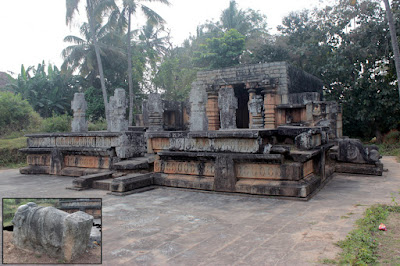Suvarneshwara Devastana is the second largest of the four temples in & around Halasi. This village was once a minor capital of Goa Kadamba kingdom. Halasi was also known as Halasige or Palasige or Palasika as per an inscription.
December 15, 2021
This spot was the final item on my itinerary of the day. In the morning I trekked to Raamteerth which was around 8 km, both ways. A short break for breakfast. Then I headed to Machigad fort, its a 10 to 12 minute climb from the village to the hill fort. By 2 PM I was at Bhu-Varaha Devastana, spent an hour there. Next was Kalmeshwara Devastana which is 5 minute walk fron BhuVaraha temple. I arrived at Suvarneshwara Devastana famished, I wanted a break from walking.The temple premises is well kept, clean and neat, it had a peaceful ambiance. This would be a perfect place to have lunch. So, I washed my arms and face, what a refreshing effect it had. Found a shady spot and had lunch- chapati, green-gram and cucumbers. The short break recharged my energy level.
First I went around the exterior. As you see the temple is built on a high platform. Looks like the builders had a grand plan but it remained incomplete for some reason.
The walls are built of granite blocks. The design is basic, purely functional, hardly any decorative art to be found anywhere.
The overall length & width of this temple is approximately 70' and 37'. If the Shikhara was built, the overall height of this temple might have been 40' to 45'. Definitely whoever had this built wanted this temple to the largest at Halasi.
This is the northern entrance. BTW, this temple is east facing and has entrances on east, south and north. Let's climb the steps and check the interior. With the missing roof, it's not really interior but technically the space was meant to be enclosed.
Here I'll quote the description of Suvarveshwara Devastana from ASI Dharwad Circle website: Locally known as Suvarnesvara is built of granite stone, is an ekakuta structure and on plan has garbhagriha, ardhamandapa and four pillared open navaranga. A huge linga is placed inside the garbhagriha.
A diagonal view of the Navaranga Mantapa. This is the stage of the temple reserved for dance performance in honor of the deity.
View of the Naravranga Mantapa from the southern entrance. The temple is symmetric in plan in the east-west axis.
Notice the two stones on the floor? They are the stepping stones for the Sukanasi. The Sukanasi is quite high from the floor. To sit on the Sukanasi, one has to climb over a stepping stone. This temple's proportions are 1.5x compared to other temples.
The Sabhamantapa as seen from a corner. There are four niches which are made to place idols of Ganesha, Nagadeva, Saptamatrika, and so on. The chief idol of this temple is a Shivalinga. As you see the temple is kept clean, daily pooje is carried out by local people.
Done with Suvarneshwara Devastana, I prepare to leave. One last look at the temple ...had it been completed, it would have been a grand edifice.
Apart from the four temples, there's one more temple which is said to be a Jain Basadi. The architecture is similar. Probably this structure was also built during the XII Century CE.
The final piece seen at Halasi was the neglected memorial stone on the road side. This beautiful piece of art, stand fixed, probably at it's original position. Its a memorial in honor of a woman who sacrificed her life protecting people or place.
Done with the monuments of Halasi, I head out of the village.
One other temple I had in mind was Kalmeshwara Devastana at Golihalli, I dropped the thought of going after it as I was tired, had an hour's drive ahead of me and a few chores back at home.
.........

















































